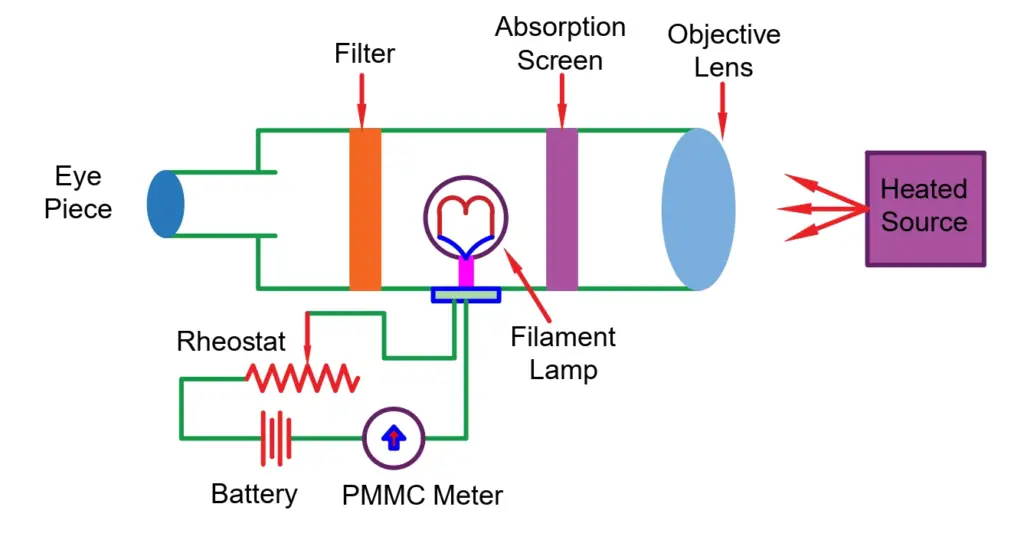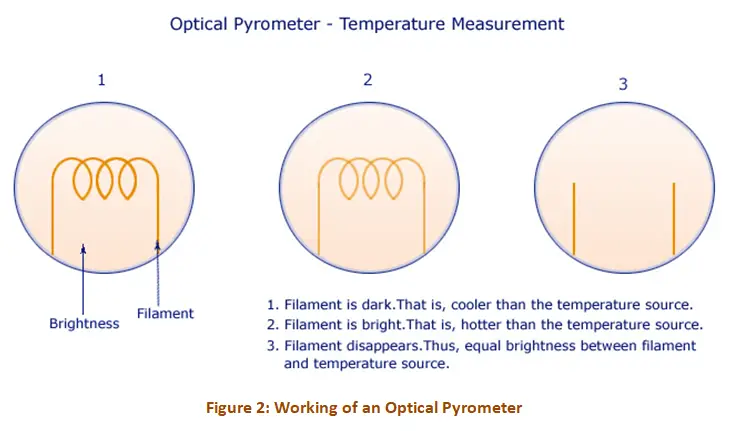Definition: The optical pyrometer functions on the principle of matching the brightness of an object to the brightness of the filament. It is a non-contact temperature measuring device.
Temperature Measurement
Temperature: The temperature of an object or substance is the measurement of its hotness or coldness. The thermal state of a body, which determines whether the body will give heat to or receive heat from other bodies, is called temperature. Temperature is measured in various units: Kelvin (K), Celsius (C), Fahrenheit (F), Rankine (R), and Reaumur (R’).
Temperature is a fundamental parameter and a widely measured and controlled industrial variable.
For measuring temperature, different methods are available. They are:
- Expansion Thermometers
- Filled-system Thermometers
- Electrical Temperature Instruments
- Optical Pyrometer
- Radiation Pyrometers
All these methods are classified based on the nature of the change produced in the testing body by the change in temperature. Today in this article we will discuss pyrometers.
What are Pyrometers?
The expansion thermometers, filled-system thermometers, and electrical temperature instruments all need physical contact with the body whose temperature is to be measured. In a situation where the temperature of the body is very high, above 1400°C, the thermometer has chances of melting due to direct contact. In some cases, the body is moving. In all these situations, a non-contact type of temperature measurement is the most useful.
What is Pyrometry?
Pyrometry is a technique that measures temperature without any physical contact. The measurement depends on the relationship between the temperature of the body and the electromagnetic radiation emitted by the body. When a body is heated, thermal energy is emitted by it, which is called heat radiation. Pyrometry is a technique for measuring a body’s temperature by measuring the electromagnetic radiation emitted by it.
Pyrometers are of two types:
- Radiation Pyromete
- Optical Pyrometer
In this article, we will discuss optical pyrometers in detail.
Working Principles of Optical Pyrometer
An optical pyrometer is a non-contact temperature-measuring device. The working principle of an optical pyrometer is such that it matches the brightness of an object to the brightness of the filament that’s placed inside the pyrometer.
The heat radiation by the object is usually infrared radiation, which is referred to as the measurement type because the majority of the radiation lies in the electromagnetic spectrum of the infrared domain. The infrared domain lies in the spectrum above the visible red light. The pyrometer measures the temperature of the energy emitted of the object and it converts the incoming signal into an electrical signal.
Construction of an Optical Pyrometer
An optical pyrometer is a cylindrical-shaped device within which a lens is placed on one end and an eyepiece on the other end. A lamp is placed between the eyepiece and the lens. A filter is placed in front of the eyepiece. The filter will help to get monochromatic light. The filter is usually a red filter, which helps narrow the band of wavelength. The lamp between the eyepiece and the objective lens has a filament that is connected to a battery, an ammeter, and a rheostat.

Working of an Optical Pyrometer
In an optical pyrometer, a comparison of brightness is made to measure the temperature of the object.
The lens will focus the radiated energy from the heated object and target it at the electric filament lamp. The intensity of the filament will depend on the amount of current that passes through it. So, an adjustable current is passed through it.
At first, when the hot object is viewed through the pyrometer, the filament first appears as a dark line against the glowing background (as shown in Fig. 2 (1)). On rotating the rheostat, the current in the filament is varied, and the temperature of the filament is progressively increased until the visible radiation matches that of the hot object.
This is achieved when the tip of the filament becomes invisible against the background (as shown in Fig. 2(3)). At this stage, the temperature can be read from the galvanometer. Caution must be taken when noting the reading from the galvanometer that the rheostat should not be moved after the temperature match is obtained.
When the filament of the optical pyrometer is:
- Too dark: the dark filament is an indication that the temperature of the filament is cooler than the temperature of the object to be measured.
- Too bright: the light filament is an indication that the temperature of the filament is hotter than the temperature of the object to be measured.
- Disappears: The disappearance of the filament is an indication that the filament and object have the same brightness. Hence, the reading would be correct.
An absorption screen is used between the object and the filament so that the radiation from the object to the filament is reduced. A monochromatic red screen is also fitted to the eyepiece so that it may be brought into the field of vision.
The function of the red screen is to eliminate color differences between the filament and the hot body so as to facilitate matching and also prevent dazzle at higher filament temperatures.
Optical pyrometers generally provide a measuring range between 600 and 3000°C.

Advantages of Optical Pyrometer
- They possess flexibility, portability and are convenient to use.
- Used for measuring high temperatures
- Light in weight.
- Can measure the temperature of moving or distant objects
- They do not need contact with the object to be measured.
- Good accuracy.
Disadvantages of Optical Pyrometer
- They cannot be used for measuring the temperature of clean-burning gases, which do not radiate visible energy.
- Optical Pyrometer is relatively expensive.
- Prone to human errors, which may be caused by the operator during the adjustment of the temperature dial.
- They are also subject to emissivity errors.
Applications of Optical Pyrometer
- Used for measuring the temperature of highly heated metals.
- Used for measuring the temperatures of furnaces.
- They are widely used in critical process measurements in semiconductors, medical, crystal growth, furnace control, etc.